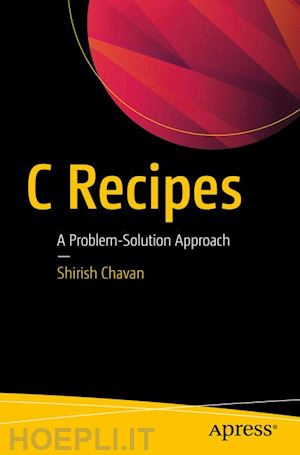

Questo prodotto usufruisce delle SPEDIZIONI GRATIS
selezionando l'opzione Corriere Veloce in fase di ordine.
Pagabile anche con Carta della cultura giovani e del merito, 18App Bonus Cultura e Carta del Docente
Solve your C programming problems with practical and informative recipes. This book covers various aspects of C programming including the fundamentals of C, operators and expressions, control statements, recursion, and user-defined functions. Each chapter contains a series of recipes that you can easily reference to quickly find the answers you are looking for.
C Recipes also contains recipes and solutions for problems in memory management, arrays, standard input and output, structures and unions, pointers, self-referential structures, data files, pre-processor directives, and library functions.
Master operators and expressions
Write user-defined functions
Work with structures and unions
Use pointers
Define self referential structures
Leverage library functions
01. Welcome to C. - 02. Control Statements. - 03. Functions and Arrays. - 04. Pointers and Arrays. - 05. Functions and Structures with Pointers. - 06. Data Files. - 07. Self Referential Structures.- 08. Stacks and Queues. - 09. Searching and Sorting. - 10. Cryptographic Systems. - 11. Numeric Methods











Il sito utilizza cookie ed altri strumenti di tracciamento che raccolgono informazioni dal dispositivo dell’utente. Oltre ai cookie tecnici ed analitici aggregati, strettamente necessari per il funzionamento di questo sito web, previo consenso dell’utente possono essere installati cookie di profilazione e marketing e cookie dei social media. Cliccando su “Accetto tutti i cookie” saranno attivate tutte le categorie di cookie. Per accettare solo deterninate categorie di cookie, cliccare invece su “Impostazioni cookie”. Chiudendo il banner o continuando a navigare saranno installati solo cookie tecnici. Per maggiori dettagli, consultare la Cookie Policy.